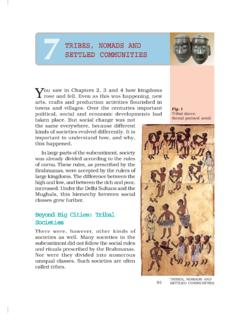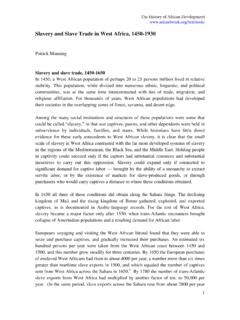Transcription of The Book of Alternative Services of the Anglican Church of ...
1 Alternative Services The book of Alternative Services of the Anglican Church of Canada with the Revised Common Lectionary Anglican book Centre Toronto, Canada . Copyright 1985 by the General Synod of the Anglican Church of Canada ABC Publishing, Anglican book Centre General Synod of the Anglican Church of Canada 80 Hayden Street, Toronto, Ontario, Canada M4Y 3G2. All rights reserved. No part of this book may be reproduced, stored in a retrieval system, or transmitted, in any form or by any means, electronic, mechanical, photocopying, recording, or otherwise, without the written permission of the publisher. Acknowledgements and copyrights appear on pages 925-928, which constitute a continuation of the copyright page. In the Proper of the Church Year (p. 262ff) the citations from the Revised Common Lectionary (Consultation on Common Texts, 1992) replace those from the Common Lectionary (1983).
2 Fifteenth Printing with Revisions. Manufactured in Canada. Canadian Cataloguing in Publication Data Anglican Church of Canada. The book of Alternative Services of the Anglican Church of Canada. Authorized by the Thirtieth Session of the General Synod of the Anglican Church of Canada, 1983. Prepared by the Doctrine and Worship Committee of the General Synod of the Anglican Church of Canada. ISBN 978-0-919891-27-2. 1. Anglican Church of Canada - Liturgy - Texts. I. Anglican Church of Canada. General Synod. II. Anglican Church of Canada. Doctrine and Worship Committee. III. Title. BX5616. A5 1985 264'.03 C84-099749-3. Vinyl Green 978-0-919891-27-2 Leatherette Green 978-1-55126-399-1. Leather Burgundy 978-1-55126-060-0 Leatherette Burgundy 978-1-55126-400-4. Leather Green 978-1-55126-001-3. Table of Contents Introduction 7. The Calendar 14. The Divine Office Daily Prayer 36.
3 The Penitential Rite 45. Morning Prayer 47. Prayers at Mid-day 56. Evening Prayer 61. Canticles 72. Introductory Responses 96. Responsories 101. Litanies, Thanksgivings, and Collects 110. Vigil of the Resurrection 133. The Great Litany 138. Baptism and Reconciliation Holy Baptism 146. Holy Baptism 150. The Reconciliation of a Penitent 166. The Reconciliation of a Penitent 167. The Reconciliation of a Penitent A Short Form 171. The Holy Eucharist The Holy Eucharist 174. The Holy Eucharist 183. A Penitential Order 216. The Holy Eucharist A Form in the Language of the book of Common Prayer 1962 229. Communion under Special Circumstances 256. The Proper of the Church Year The Proper of the Church Year 262. Sundays and Holy Days 266. Ash Wednesday 281, The Sunday of the Passion 297. Maundy Thursday 304, Good Friday 308. The Great Vigil of Easter 321.
4 Saints' Days and Other Holy Days 398. Alphabetical List of Abbreviations 448. Daily Office Lectionary 450. Weekday Eucharist Lectionary 498. A Short Table of Psalms and Readings 524. Pastoral Offices Celebration and Blessing of a Marriage with the Holy Eucharist 526. Celebration and Blessing of a Marriage 541. Ministry to the Sick 551. Ministry to the Sick 554. Ministry at the Time of Death 559. The Funeral Liturgy 565. The Funeral Liturgy Form I 571. The Funeral Liturgy Form II 589. The Funeral Liturgy Form III 598. The Interment of Ashes 599. Thanksgiving for the Gift of a Child 606. Thanksgiving for the Gift of a Child 609. Episcopal Offices The Blessing of Oil 616. The Blessing of Oil 617. Confirmation 623. Preface to the Ordination Rites 631. Ordination of a Bishop 632. Ordination of a Priest 642. Ordination of a Deacon 651. Parish Thanksgiving and Prayers Thanksgiving on the Anniversary of a Parish 668.
5 Occasional Prayers 675. Home Prayers 685. Home Prayers 686. The Psalter The Psalter 700. The Psalter 705. Music Responses for the Offices 912, Litany Responses 915. The Lord's Prayer 918, Responses for the Eucharist 920. Introduction On 29 January 1971, the General Synod of the Anglican Church of Canada resolved to direct the National Executive Council, to initiate a process of revision of Church Services without delay, which will produce alternatives to Services now offered by the 1959. Canadian book of Common Prayer; and which will provide guidelines for their use throughout the Anglican Church of Canada. The Synod also resolved, that in future revisions of our Common Prayer book , more emphasis be given to permissive forms and less to mandatory forms of public worship, in order that in the use of one common book , we may still achieve that flexibility and variety we deem desirable.
6 And that in the meantime General Synod be asked to give guidance to diocesan authorities in relaxing the rigid conformist notes still written into our Common Prayer book . By these and other resolutions the General Synod channelled and directed a movement for liturgical change which already existed, and inaugurated a period of experiment, evaluation, and change. Between 1974 and 1978, the Doctrine and Worship Committee produced the Canadian Anglican Liturgical Series, composed of the following publications: Christian Initiation (1974), The Holy Eucharist (1974), Institution and Induction (1974), Christian Initiation: Study Document (1975), Thanksgiving for Birth or Adoption (1978), Celebration and Blessing of a Marriage (1978). This series constituted the first step in the implementation of the resolutions of the General Synod of 1971. which related to the area of liturgy.
7 On 23 June 1980, the Doctrine and Worship Committee submitted a new collection of liturgical texts to the General Synod, including a new form of the eucharist, Third Canadian Eucharist (1979). Most of these texts were approved (either explicitly or tacitly), some with the conditions of further negotiation and editing. They were subsequently published as The Lectionary (1980), Calendar of the Church Year (1981), Holy Eucharist: Third Canadian Order (1981), Alternative Ordinal (1982), and Holy Week (1982). A new form for the Celebration and Blessing of a Marriage was published in 1982. The 1980 General Synod made two other significant decisions Introduction 7. regarding the liturgy of the Church . First, it rejected a proposal to proceed with the preparation of a revised book of Common Prayer. Second, it directed the Doctrine and Worship Committee, to proceed with the development of a book of Alternative Services , comprised of the commonly used Services in the present Canadian Anglican Liturgical Series, revised where necessary, together with similar other Services , for presentation to the next General Synod.
8 By these two actions the General Synod committed the Anglican Church of Canada, for the time being at least, to a pattern found also in the Church of England and the Anglican Church of Australia, in which the traditional rites of the Church coexist with contemporary and Alternative rites. This book of Alternative Services is therefore not a new book of Common Prayer and does not replace it. In 1983, the Doctrine and Worship Committee returned to the General Synod with a draft book of Alternative Services which required further editing and revision. The General Synod authorized the committee to complete its task and to take the book to the National Executive Council for permission to publish for use, where permitted by the diocesan bishop, at least until the thirty-second General Synod (scheduled for 1989). It may be seen from this brief history that the book of Alternative Services , now presented for use, reflects more than fourteen years of continuous research, experimentation, criticism, and evaluation.
9 This task has involved not only a succession of committees but a vast number of worshippers, lay people as well as clergy, who have worked in the movement for liturgical change. Liturgical change is sometimes treated as a phenomenon unique to the twentieth century, a counter-current in the flow of Anglican piety. The truth is that the distinctive ethos of Anglicanism emerged in a period of reformation which was characterized by even greater liturgical change than our own. This comparison of the present day with the Reformation era is important for an understanding of the contemporary liturgical scene. The spirit of reformation is neither anarchic nor destructive, but is rooted in the conviction that in times of great insecurity and change the centre cannot be held by a blind preservation of the forms in which tradition has been received, but only through diligent and passionate search for fresh expressions and 8 Introduction evocations of the tradition.
10 The wonder is not that so many twentieth century Christians are open to change but that the experiments of the Reformation era appeared to be treated as definitive for nearly four centuries. The gospel always has a reforming, reinterpreting edge to it, and the gospel is always the proper subject of the liturgy. While there is a strong correspondence between the dynamics of the Reformation era and the present day, there is considerable difference in detail, rising from different perspectives in the Church 's understanding of itself and the world around it. The Reformation of the sixteenth century occurred at a time when Church and State enjoyed a relationship of comfortable interdependence (although the very political forces that embraced the Reformation were at the same time producing new and secular forms of government, which would eventually marginalize the Church ).






